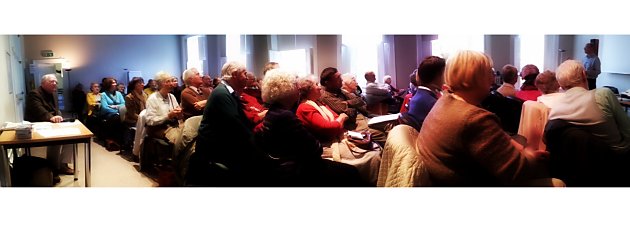20-21st October 2012: Two years ago BRLSI ran a hugely successful weekend symposium on Modernism, and this year’s weekend on Romanticism – The Arts in Europe 1780-1840 proved equally popular, with the Elwin Room packed to capacity for all eight lectures over the two days.
A 9:45am Saturday start proved no deterrent for the audience, who were rewarded with a tour de force by Dr Diego Saglia (right) of Parma University, answering the question What Was Romanticism? In a lighthearted yet scholarly overview he covered the big names such as Shelley and Byron, but also less known figures including Madame de Staël, “the most dangerous woman in Europe – writer, polemicist and pain in the neck!”
Next came a speaker from closer to home – Dr Alexander Sturgis, Director of the Holburne Museum in Bath and no stranger to BRLSI. His subject was The Romantic Image of the Artist in France and Britain. Romanticism had, he said, “a very high opinion of the role of the artist, and artistic genius”, and played up to it. Romantic artists’ representations of themselves created a legacy which endured well beyond 1840, as he illustrated with examples of later artists, including Gauguin and Van Gogh.
Saturday’s third speaker was Dr Bradley Stephens (left) of Bristol University, on Victor Hugo and his Contemporaries – The Second Wave of French Romanticism. Dr Stephens began on a specific day – 25th February 1830 – which saw the first performance of Hugo’s play Hernani, and marked the start of Romanticism’s second wave. Controversial at the time (a pitched battle erupted between Romantics and outraged Classicists in the audience), Hernani emboldened Hugo and his contemporaries.
The day ended with Prof David Wyn Jones, of Cardiff University, on Haydn, Austria and Britain. Haydn, though Austrian, developed a great attachment for Britain, even writing The Battle of the Nile for Emma Hamilton to sing before Lord Nelson. His most prestigious commission, however, was the one which became two national anthems (Austria and, as Deutschland über alles, Germany) plus an Anglian hymn. In what may well have been a first UK performance, Prof Wyn Jones accompanied the audience on piano in an impromptu rendition of the original Austrian version, with some very fine voices apparent.
If you think German Romantic Painting of the 19th Century might be a dull topic, think again. On Sunday morning James Malpas, Director of Short Courses at Christie’s Education, spoke with gusto on Caspar David Friedrich (1774 – 1840), a man who undertook long marches in German Romantic costume (officially banned at the time) and pre-dated Einstein with some of his ideas on the nature of matter. James Malpas treated the audience to vivid interpretations of works including Monk by the Shore and Abbey in the Oak Wood, and located Friedrich in relation to other European artists of the time.
No event on Romanticism would be complete without its most determined enfant terrible, Percy Bysshe Shelley, and Dr Ann Wroe (right) of The Economist (and author of Being Shelley) did the honours this time. In Shelley’s Spiritual Quest she described the apparent paradox of a man who was sent down from Oxford for refusing to disavow his pamphlet The Necessity of Atheism, yet later wrote of ‘visitations of the divinity in man’. Shelley, as Dr Wroe put it, was “not a pastoral poet” – among other things he took arsenic, played with pistols and nearly drowned himself, all in the name of finding truth. He actually was drowned as a result of a boating accident in Italy, aged 29.
In Romantics and Romanticisms – German Literature 1795-1830, Prof Robert Vilain of Bristol University described the three phases of German Romanticism, from Early, with Schlegel and Novalis, to the Heidelberg-based High (with a cast including the Brothers Grimm), and on to the Late period in Berlin, with E.T.A. Hoffmann, the inspiration for Offenbach’s Tales of Hoffmann opera. Their philosophy, derived from Kant, favoured “love over learning, poetry over empiricism”, while their preoccupations included the unconscious, automata and journeys, and they favoured fragments and improvisation over structure.
Ending the symposium was Prof William Hughes (left) of Bath Spa University, with The Romantic Hero. This was a Gothic tale in every sense, as Prof Hughes began a spirited lecture with Manfred, the seriously wrong-doing Gothic hero of Horace Walpole’s novel The Castle of Otranto (1764), and traced the line through The Italian by Anne Radcliffe (moral – Monks are bad news!) to Byron’s The Giaour (Infidel) in 1813. Gothic heroes, we learned, committed their crimes in view then died or went into monasteries, whereas Romantic Heroes transgressed off-stage and were seen paying for it for the rest of their lives and beyond. In Romantic terms, Prof Hughes told us, Heroism was “a set of rules for those who won’t be bound by rules”. It was a suitably Romantic idea with which to close the weekend.
Watch the video of the Symposium (12 mins):
European Romanticism was devised and organised by Dr Robert Blackburn (right), BRLSI’s Convenor of Literature and Humanities, who also organised 2010’s Modernism weekend – a huge thank-you to Robert for all his efforts (and good luck with the Wagner Weekend in 2014!). Thanks go to all our speakers who made the event such a success (with many audience members attending all eight lectures), while honourable mentions are also due to Bob Draper and Janet and David Cunliffe-Jones, who provided essential intermission refreshments in the Lonsdale Room.
● If you missed the weekend, don’t worry – BRLSI runs a programme of lectures all year round (except August), covering subjects from science and architecture to poetry and world affairs. Click here for details of this month’s programme.
Paul Stephens

